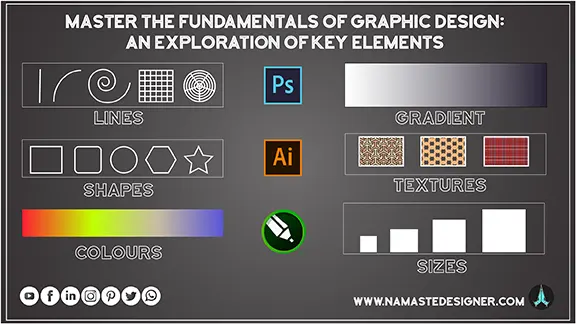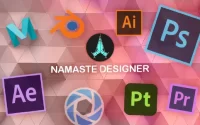Master the Fundamentals of Graphic Design: An Exploration of Key Elements

Fundamentals of Graphic Design
Graphic design is a unique blend of art and technology that utilizes visual elements to communicate messages. Whether you aim to create logos, websites, advertisements, or packaging, a robust grasp of the basics is critical for success. This article delves into the fundamental elements of graphic design, illuminating tips for mastering them. Many graphic designers are employed in specialized design services, publishing, or advertising, public relations, and related services industries.
Color Theory
A Vital Tool for Success Color holds a prominent place in graphic design, and a thorough comprehension of color theory is crucial. Color theory encompasses the utilization of contrasts and combinations of hues to create visual interest and convey meaning, including concepts like saturation, value, hue, and complementary colors. By mastering color theory, you can use color to evoke mood, establish balance, and reinforce brand image effectively. For example, color palettes that feature analogous colors evoke a feeling of harmony and create a calming effect.
Typography
The Art and Technique of Arranging Type Typography is the art and science of arranging type to make written language readable and legible. In graphic design, typography creates a visual hierarchy, adds interest, and reinforces the overall design. Choosing the appropriate typeface and understanding the basics of kerning, tracking, and line spacing are critical for success. By mastering typography, you can communicate messages effectively and create designs that are easy to read. For example, using a sans serif font such as Helvetica for body text will help to create a modern, clean look, while a serif font such as Times New Roman is more appropriate for traditional, formal projects.
Composition and Layout
Arranging Elements Within a Design Composition and layout refers to the arrangement of elements within a design. A strong composition is imperative for creating visual interest and guiding the viewer’s attention to crucial elements, including balance, proportion, and hierarchy. By mastering these concepts, you can arrange elements within a design harmoniously and aesthetically, producing pleasing compositions. Composition and layout are like building a house. You need a strong foundation and plan to arrange the elements in a logical, harmonious way to create a unified and visually appealing structure.
Image Selection and Editing
Enhancing Designs with Images Images play a crucial role in many graphic design projects, and selecting the right images can significantly enhance your designs. When choosing images, consider factors such as resolution, size, and subject matter, and familiarize yourself with the basics of editing, such as cropping, resizing, and color correction. By mastering these skills, you can use images effectively to reinforce messages and create visually engaging designs. For instance, you can crop an image to focus on a single object, adjust its size to fit the layout, and add a warm color filter to give it a more inviting feel.
Branding
Creating a Unique Visual Identity Branding involves creating a distinctive visual identity for a company or product, encompassing elements such as logos, color schemes, typography, and other visual elements that define the brand’s style. A strong brand image is vital for recognition and building a connection with your audience. By mastering the fundamentals of branding, you can create a recognizable and cohesive visual identity for your business or product. A strong brand image can help differentiate a company or product from its competitors and create a memorable impression on customers. It also helps to create trust and loyalty among customers, and can be used to create a sense of community around a product or company. For example, Apple’s logo, the bitten apple, and their slogan “Think Different” are easily recognizable and evoke a strong brand image that resonates with their customers.
Closing Thoughts: Fundamentals of Graphic Design
Mastering the fundamentals of graphic design is crucial for success in the field. Understanding color theory, typography, composition and layout, image selection and editing, and branding equips you with the skills to create effective and visually engaging designs that communicate messages and reinforce brand image. For example, a basic understanding of color theory allows you to pick a color palette that works together to convey a certain emotion or feeling, while understanding typography allows you to choose readable fonts while reinforcing the message or brand. You can become a skilled and successful graphic designer with dedication, practice, and time.
Looking for more insights?
Read more: Stay Ahead of the Game with Minimalist Graphic Design Trends
Let’s Together Bring Your Creative Visions to Life
Don’t let your creative visions remain just ideas. Our team of design experts is ready to collaborate with you to bring your dreams to life. Contact us today to learn more about our extensive design services and how we can help you achieve your goals. Let’s work together to create stunning visuals that will leave a lasting impact. Reach us at [email protected] or +91-8053299861.
Connect with Us
Email | Bio | Blog | Facebook | Instagram | LinkedIn | Medium | Pinterest | Publish0x | Quora | Reddit | Telegram | Twitter | WhatsApp | YouTube



